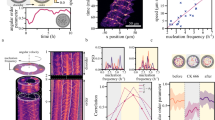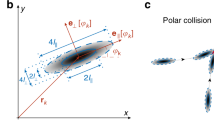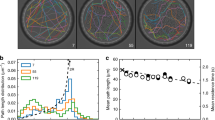Abstract
From the formation of animal flocks to the emergence of coordinated motion in bacterial swarms, populations of motile organisms at all scales display coherent collective motion. This consistent behaviour strongly contrasts with the difference in communication abilities between the individuals. On the basis of this universal feature, it has been proposed that alignment rules at the individual level could solely account for the emergence of unidirectional motion at the group level1,2,3,4. This hypothesis has been supported by agent-based simulations1,5,6. However, more complex collective behaviours have been systematically found in experiments, including the formation of vortices7,8,9, fluctuating swarms7,10, clustering11,12 and swirling13,14,15,16. All these (living and man-made) model systems (bacteria9,10,16, biofilaments and molecular motors7,8,13, shaken grains14,15 and reactive colloids11,12) predominantly rely on actual collisions to generate collective motion. As a result, the potential local alignment rules are entangled with more complex, and often unknown, interactions. The large-scale behaviour of the populations therefore strongly depends on these uncontrolled microscopic couplings, which are extremely challenging to measure and describe theoretically. Here we report that dilute populations of millions of colloidal rolling particles self-organize to achieve coherent motion in a unique direction, with very few density and velocity fluctuations. Quantitatively identifying the microscopic interactions between the rollers allows a theoretical description of this polar-liquid state. Comparison of the theory with experiment suggests that hydrodynamic interactions promote the emergence of collective motion either in the form of a single macroscopic ‘flock’, at low densities, or in that of a homogenous polar phase, at higher densities. Furthermore, hydrodynamics protects the polar-liquid state from the giant density fluctuations that were hitherto considered the hallmark of populations of self-propelled particles2,3,17. Our experiments demonstrate that genuine physical interactions at the individual level are sufficient to set homogeneous active populations into stable directed motion.
This is a preview of subscription content, access via your institution
Access options
Subscribe to this journal
Receive 51 print issues and online access
$199.00 per year
only $3.90 per issue
Buy this article
- Purchase on Springer Link
- Instant access to full article PDF
Prices may be subject to local taxes which are calculated during checkout




Similar content being viewed by others
References
Vicsek, T., Czirók, A., Ben-Jacob, E., Cohen, I. & Shochet, O. Novel type of phase transition in a system of self-driven particles. Phys. Rev. Lett. 75, 1226–1229 (1995)
Toner, J., Tu, Y. & Ramaswamy, S. Hydrodynamics and phases of flocks. Ann. Phys. 318, 170–244 (2005)
Marchetti, M. C. et al. Hydrodynamics of soft active matter. Rev. Mod. Phys. 85, 1143–1189 (2013)
Vicsek, T. & Zafeiris, A. Collective motion. Phys. Rep. 517, 71–140 (2012)
Grégoire, G. & Chaté, H. Onset of collective and cohesive motion. Phys. Rev. Lett. 92, 025702 (2004)
Buhl, J. et al. From disorder to order in marching locusts. Science 312, 1402–1406 (2006)
Schaller, V., Weber, C., Semmrich, C., Frey, E. & Bausch, A. R. Polar patterns of driven filaments. Nature 467, 73–77 (2010)
Sumino, Y. et al. Large-scale vortex lattice emerging from collectively moving microtubules. Nature 483, 448–452 (2012)
Wioland, H., Woodhouse, F. G., Dunkel, J., Kessler, J. O. & Goldstein, R. E. Confinement stabilizes a bacterial suspension into a spiral vortex. Phys. Rev. Lett. 110, 268102 (2013)
Zhang, H. P., Be’er, A., Florin, E.-L. & Swinney, H. L. Collective motion and density fluctuations in bacterial colonies. Proc. Natl Acad. Sci. USA 107, 13626–13630 (2010)
Theurkauff, I., Cottin-Bizonne, C., Palacci, J., Ybert, C. & Bocquet, L. Dynamic clustering in active colloidal suspensions with chemical signaling. Phys. Rev. Lett. 108, 268303 (2012)
Palacci, J., Sacanna, S., Steinberg, A. P., Pine, D. J. & Chaikin, P. M. Living crystals of light-activated colloidal surfers. Science 339, 936–940 (2013)
Sanchez, T., Chen, D. T. N., DeCamp, S., Heymann, M. & Dogic, Z. Spontaneous motion in hierarchically assembled active matter. Nature 491, 431–434 (2012)
Deseigne, J., Dauchot, O. & Chaté, H. Collective motion of vibrated polar disks. Phys. Rev. Lett. 105, 098001 (2010)
Kudrolli, A., Lumay, G., Volfson, D. & Tsimring, L. Swarming and swirling in self-propelled polar granular rods. Phys. Rev. Lett. 100, 058001 (2008)
Dombrowski, C., Cisneros, L., Chatkaew, S., Goldstein, R. E. & Kessler, J. O. Self-concentration and large-scale coherence in bacterial dynamics. Phys. Rev. Lett. 93, 098103 (2004)
Aditi Simha, R. & Ramaswamy, S. Hydrodynamic fluctuations and instabilities in ordered suspensions of self-propelled particles. Phys. Rev. Lett. 89, 058101 (2002)
Quincke, G. Ueber Rotationen im constanten electrischen Felde. Ann. Phys. Chem. 59, 417–486 (1896)
Melcher, J. R. & Taylor, G. I. Electrohydrodynamics: a review of the role of interfacial shear stresses. Annu. Rev. Fluid Mech. 1, 111–146 (1969)
O’Loan, O. J. & Evans, M. R. Alternating steady state in one-dimensional flocking. J. Phys. A 32, L99 (1999)
Chaté, H., Ginelli, F., Grégoire, G. & Raynaud, F. Collective motion of self-propelled particles interacting without cohesion. Phys. Rev. E 77, 046113 (2008)
Bertin, E., Droz, M. & Grégoire, G. Hydrodynamic equations for self-propelled particles: microscopic derivation and stability analysis. J. Phys. A 42, 445001 (2009)
Hackborn, W. W. Asymmetric Stokes flow between parallel planes due to a rotlet. J. Fluid Mech. 218, 531–546 (1990)
Brotto, T., Caussin, J.-B., Lauga, E. & Bartolo, D. Hydrodynamics of confined active fluids. Phys. Rev. Lett. 110, 038101 (2013)
Farrell, F. D. C., Marchetti, M. C., Marenduzzo, D. & Tailleur, J. Pattern formation in self-propelled particles with density-dependent motility. Phys. Rev. Lett. 108, 248101 (2012)
Schaller, V. & Bausch, A. R. Topological defects and density fluctuations in collectively moving systems. Proc. Natl Acad. Sci. USA 110, 4488–4493 (2013)
Crocker, J. C. & Grier, G. Methods of digital video microscopy for colloidal studies. J. Colloid Interface Sci. 179, 298–310 (1996)
Acknowledgements
We acknowledge support from the Paris Emergence programme (D.B.), C’Nano IdF (D.B.) and the Institut Universitaire de France (D.B.). We thank L. S. Tuckerman and H. Chaté for their useful comments and suggestions.
Author information
Authors and Affiliations
Contributions
A.B. and N.D. performed the experiments. A.B., N.D., O.D. and D.B. analysed the experimental results. D.B. conceived the project and designed the experiments. J.-B.C. and D.B. worked out the theory and wrote the Supplementary Methods. J.-B.C., O.D. and D.B. wrote the paper.
Corresponding author
Ethics declarations
Competing interests
The authors declare no competing financial interests.
Supplementary information
Supplementary Information
This file contains Supplementary Methods, Text and Data, Supplementary Figures 1-8 and additional references. Additional information is given about the theoretical results outlined in the main paper and the transition to collective motion, and the properties of the polar phases, are investigated from a microscopic model. (PDF 515 kb)
Isotropic state (close view)
E0/EQ = 1.39, Φ0=6x10-4, L=72.6 mm, W=1.0 mm, acquisition rate 180 fps, video frame rate18 fps. (MOV 7475 kb)
Band propagation in a racetrack-shaped confinement
E0/EQ = 1.39, Φ0~10-2, L=72.6 mm, W=1.0 mm, acquisition rate 50 fps, video frame rate 200 fps. (MOV 7427 kb)
Band propagation in a racetrack-shaped confinement (close view)
E0/EQ = 1.39, Φ0~10-2, L=72.6 mm, W=1.0 mm, acquisition rate 180 fps, video frame rate 18 fps. (MOV 7810 kb)
A polar liquid spontaneously flowing in a racetrack-shaped confinement (close view)
E0/EQ = 1.39, Φ0=1.8x10-1, L=72.6 mm, W=1.0 mm, acquisition rate 180 fps, video frame rate 18 fps. (MOV 7521 kb)
Bouncing band in a rectangular confinement.
E0/EQ = 1.39, Φ0=1.1x10-1, L=20 mm, W=1.0 mm, acquisition rate 50 fps, video frame rate fps. (MOV 2554 kb)
A one-million-roller population in a square confinement. Large field of view and zoom in
E0/EQ = 1.39, Φ0=1.1x10-1, L=10 mm, W=10 mm, acquisition rate 25 fps, video frame rate 25 fps. (MOV 27182 kb)
Rights and permissions
About this article
Cite this article
Bricard, A., Caussin, JB., Desreumaux, N. et al. Emergence of macroscopic directed motion in populations of motile colloids. Nature 503, 95–98 (2013). https://doi.org/10.1038/nature12673
Received:
Accepted:
Published:
Issue Date:
DOI: https://doi.org/10.1038/nature12673
This article is cited by
-
Active hydraulics laws from frustration principles
Nature Physics (2024)
-
Interacting loop models explain the flows of active fluids in hydraulic networks
Nature Physics (2024)
-
Two-dimensional Brownian motion of active particle on superfluid helium surface
Scientific Reports (2023)
-
Defect-mediated dynamics of coherent structures in active nematics
Nature Physics (2023)
-
Direction-dependent dynamics of colloidal particle pairs and the Stokes-Einstein relation in quasi-two-dimensional fluids
Nature Communications (2023)
Comments
By submitting a comment you agree to abide by our Terms and Community Guidelines. If you find something abusive or that does not comply with our terms or guidelines please flag it as inappropriate.



